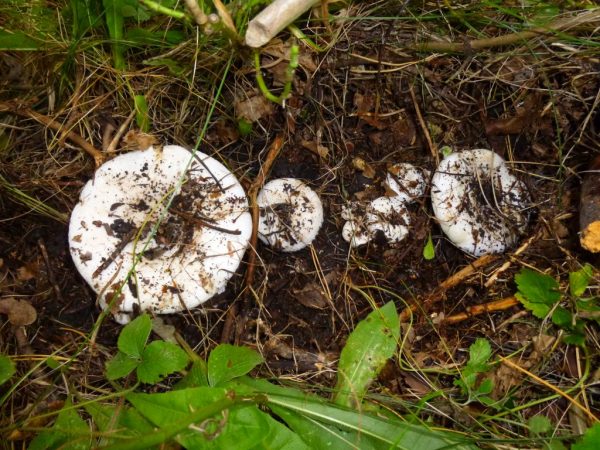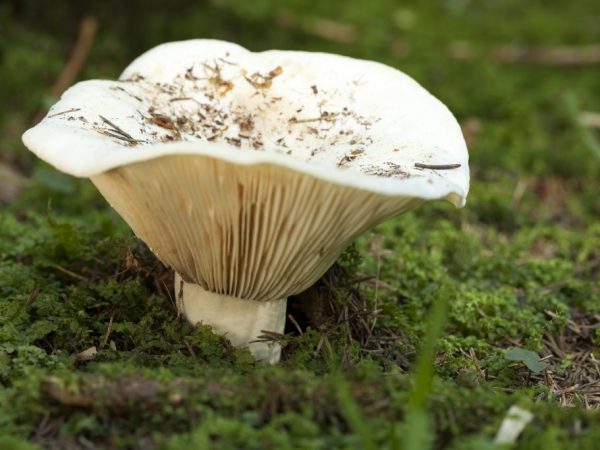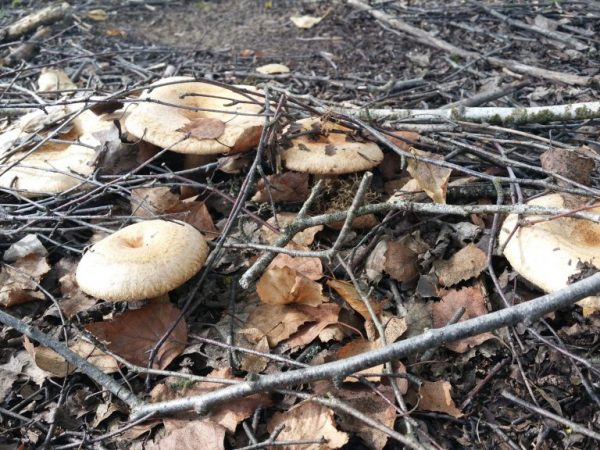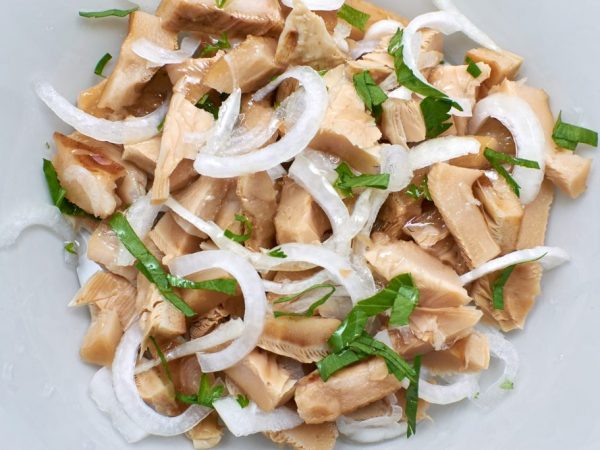Description of different types of mushrooms
Milk is the most valuable forest mushroom, from which delicious delicacies are obtained. It is salted, pickled, boiled, fried, added to the filling for pies and pies. In folk medicine, these mushrooms have occupied an important place for many centuries, thanks to their beneficial composition. Different types of mushrooms are found in the forest: they are unique and not all are edible.
- General description of mushrooms
- Description of species
- Real milk or white
- Milk yellow
- Black milk
- Parchment milk
- Fragrant lactate, or fragrant milkman
- Aspen milk
- Podgruzdok white
- Beneficial features
- Contraindications and harm
- Application
- Salting, pickling and frying
- Application in medicine
- Growing at home
- Conclusion

Description of different types of mushrooms
General description of mushrooms
The milk mushroom looks different, depending on the species. But their "family" has some common features.
Milk mushrooms belong to the genus Mlechnik, included in the russula family of the Agaricomycetes class. The mushroom has a concave or funnel-shaped cap with a diameter of 6 to 12 cm, a "terry" edge. The hymenophore is lamellar, the plates are frequent, descending along the pedicle. The legs are thick, similar in color to the cap. They become hollow with age. The pulp is yellowish, the milky juice is white and acrid, the spores are creamy.
Milk mushrooms grow mainly in damp deciduous, sometimes in coniferous forests. They are often found under spruce, poplar or birch trees. They are collected from under fallen leaves and needles, colonies sometimes have several dozen copies. Considering their large size (50–120 g), one successful trip to the forest can bring a splendid harvest. The richest mushroom areas are the northern ones.
Usually they collect and sell real milk mushrooms. The genus Mlechnik includes many other types of weeds: yellow, black, aspen, raw. Sometimes Chinese shiitake mushrooms are also classified as belonging to this genus, although this is not the case.
Europeans consider any type of milk mushroom poisonous, but in fact, only false milk mushrooms are really dangerous. Before using edible species, processing is required: they are very bitter.
All milk mushrooms are conditionally edible, Russian people have considered them a delicacy since ancient times, their usefulness is at a high level.
Description of species
Varieties of mushrooms have their own characteristics, differ in size, color, method of preparation. They prefer birch or poplar forest - they are difficult to spot.
Gathering mushrooms is like hunting: you need to go out early, move slowly through the forest and carefully examine the land under the trees, stumps. Search time comes with cool, wet weather. Typically, the growth period begins in July-August and lasts until October-November.
The most delicious milk mushrooms are white, yellow and black. Island, aromatic and other varieties are interesting, but not as popular.
If you buy already harvested milk mushrooms in the store, it is important to learn how to distinguish between them. If in doubt, it is better to show the product to experienced mushroom pickers so that they can determine if it is inedible.
Real milk or white

Milk mushrooms are difficult to find under a layer of foliage.
Real milk mushrooms are also called "raw", "white" or "wet". This is one of the largest mushrooms in Russia, but it is difficult to find it in the forests.It grows in birch forests, under stumps and trees, often completely hiding under fallen leaves and snuggling tightly to the ground.
A mushroom of this species looks like this:
- Hat: it can reach a diameter of 4 to 25 cm. At first it is flat, but with age it becomes funnel-shaped, with a noticeable depression in the center. The edge is wrapped in and shaggy. The surface is sticky and wet to the touch.
- Hat peel: white or yellowish in color, sometimes with a brown spot, forest debris adheres abundantly to it.
- Hymenophore: lamellar, the plates forming it are white and wide. Spores are yellow.
- Pulp: in a raw white breast, it is dense, white, with a fruity odor. The caustic milky juice released from it quickly turns yellow when exposed to air.
- Leg: thick, 3-7 cm high, becomes hollow in old age. The color corresponds to the color of the cap, but spots or pits are visible on it.
For your information. Gray-pink milky mushrooms are also similar to wet mushrooms - inedible and dangerous mushrooms, but unfortunately with a sweet taste of pulp. They grow in the same places and have similar shapes. The main difference between false milk mushrooms is the pink tint of the cap and legs.
Raw milk mushrooms are harvested in June-September. Before use, they are soaked in water with salt for 3 days. The liquid is changed several times every day. After processing, the real milk becomes suitable for use in food.
The white lump looks typical for its "family". Other species are similar to it, including watery-zone mushroom and oak mushroom, which has a nutty or yellowish color on the cap and the flesh turns pink on the cut.
Milk yellow
The yellow milk mushroom is popular in Russia, and its harvesting season lasts from July to October. It grows in mixed and coniferous forests, under birches and spruce. It looks almost like white, it is prepared for use in the same way. Its other name is yellow wave.
- Hat: reaches 8 to 25 cm in diameter. It is funnel-shaped, with its fluffy edges wrapped inward. The color is yellow, sometimes orangeish. The hats are sticky and slimy in rainy weather.
- Hymenophore: represented by narrow plates, which are creamy at first, with age - more yellow. Spores are creamy or white.
- Pulp: dense white with acrid and thick milky juice. Unlike the real milk mushroom, the yellow milk mushroom does not have a clear fruity aroma. The pulp tastes spicy and spicy.
- Leg: 4-6 cm long, cylindrical in shape. The color is the same as that of the cap, but slightly lighter, with brown spots.
This mushroom looks like a blue or canine milk mushroom. He also has a yellowish cap, but the milky juice and plates have a purple tint. Another similar species is the marsh mushroom, which grows in the lowlands and has red-colored caps.
Black milk
Black spruce breast is great for pickling. The picking time for mushrooms usually begins in August and lasts through October-November inclusive. This is done in birch and spruce groves. It grows in large families in the forest floor. For milk mushrooms, he has a unique appearance.
- Hat: rather large - from 8 to 20 cm, convex in youth, becomes funnel-shaped with age. The skin is dark olive or brownish, slippery and sticky to the touch in wet weather. The edges of the cap are "felt".
- Pulp: white, with caustic milky juice.
- Hymenophore: lamellar, fork-branched. Spore powder, cream.
- Leg: up to 8 cm long, one color with a hat. Thin plates descend along it (or, as the mycologists say, run down).
Spruce mushroom has a unique pungent taste and pleasant smell. It is usually salted or used fresh after soaking.
Irina Selyutina (Biologist):
Collecting a black lump is still half the battle, but the real thing is to bring it "to mind", that is. properly prepare, so that those sitting at the table only salivate from one type of these mushrooms. And it is important to make sure that these milk mushrooms do not taste bitter. Soaking in cold water will help.The time of the procedure depends on a number of factors, including the method of salting - cold or hot. If you want to make cold pickling, black milk mushrooms (and not only them) are kept in water for 5 days, with hot - only 3 days. But in any case, there is a regular change of water.
So how are black milk mushrooms prepared for salting? For this:
- Carefully scrape off the film from the surface of the cap.
- Most of the leg is cut off (a stump remains no more than 1 cm long - at the level of the cap).
- Rinse thoroughly and soak in salted water (1 tablespoon salt per 1 liter of water). In order for the fruit bodies to be completely submerged in water, they can be covered with a lid and pressed down with a load.
- The water is changed 2-4 times a day.
For your information. Boiling (most often) and blanching (in cold salting) are behind the recipes for high-quality preparation of black milk mushrooms in winter. Blanch black milk mushrooms for 5-7 minutes in boiling water with vinegar or citric acid. Boiling is carried out for 30-45 minutes.
After processing, this mushroom takes on a purple or purple color.
Parchment milk
The parchment milk mushroom is very similar in appearance to the pepperoni. Both species often grow side by side. The harvesting season is from August to September.
- Hat: with a diameter of 5 to 20 cm, on average - 10 cm. Initially flat-convex, it gradually takes the shape of a funnel. The skin covering it can be smooth or wrinkled, it is white, but turns yellow over time.
- Hymenophore: lamellar, plates are frequent, yellowish, running down the stem.
- Pulp: white, bitter. At the site of the break, white milky sap is released, which does not change color upon contact with air.
- Leg: up to 10 cm tall, with frequent yellowish plates. Narrowed downwards.
Milk parchment is used only for salting, after a long soaking.
Fragrant lactate, or fragrant milkman

The mushroom grows in birch forests
The aromatic milk mushroom is considered less tasty and healthy compared to other types. This mushroom forms mycorrhiza with birches and grows in mixed and deciduous forests. The "hunt" for him begins at the end of August.
- Hat: beige, gray-crimson, yellowish or slightly brown cap. It is small, about 7 cm in diameter. The shape is concave, with a small tubercle in the middle. The surface is uneven with concentric circles.
- Hymenophore: represented by frequent thin plates.
- Pulp: fragile, white, smells like coconut or fresh hay. Milky sap is white, does not change color.
- Leg: with a diameter of 0.5-1 cm, its length may be equal to half (or slightly more) the diameter of the cap. Smooth, becomes hollow with age, somewhat lighter in color than the cap.
The mushroom is conditionally edible, has an unremarkable taste, so it is rarely harvested. It looks like a brown, but edible counterpart.
Aspen milk
The names of this mushroom are tallow, aspen, poplar or willow. These names are not obtained by chance - they correspond to the place of its growth: it is often found under these trees.
- Hat: white fleshy, sometimes reaches a diameter of 30 cm. On average, its size ranges from 8 to 20 cm. It is depressed in the middle, and the edges of young specimens are curved and shaggy.
- Hymenophore: consists of rare plates.
- Pulp: spicy to taste, pleasantly fruity smell. White and brittle.
- Leg: low, dense.
The "quiet hunters" do not particularly appreciate the mushroom: although it is large, it has too typical taste.
Podgruzdok white
Podgruzdok is an unusual mushroom. He, unlike other members of the russula family, does not emit milky juice, his hat is not sticky.
- Leg: white and short stem.
- Hat: with a depression in the center, with rolled and wavy edges. The color is white, but turns yellow with age.
- Pulp: dense, with a pleasant smell.
- Spread: it grows in many forests, including mountainous ones. He especially loves river banks. In appearance, it is similar to the green podgruzdok with a greenish tint of the plates.
- Preliminary processing: before salting and drying, the varieties must be thoroughly washed and soaked for a long time.
Beneficial features
Milk mushrooms are healthy foods suitable for a variety of diets. Frozen and salted, they do not lose their medicinal properties. The calorie content is low: they contain only 19 kcal per 100 g. The calorie content of pickled milk mushrooms is slightly higher - 26 kcal. It contains a lot of vitamins and proteins.
The benefit is that the data that mushrooms help against neuroses and depression, inflammatory processes, and stomach problems. They are suitable for diabetics and those who are losing weight: the proteins of the milk are well absorbed by the body, and they also normalize blood glucose levels.
Contraindications and harm
Even edible milk mushrooms are forbidden to eat without preliminary processing. They are first soaked or boiled for a long time, and only then they are salted or pickled. The reason is too caustic milky juice. All types of milk mushrooms are contraindicated for pregnant and lactating mothers, children under 7 years old, as well as people suffering from stomach ulcers, liver and pancreas diseases. The product can be harmful: cause an acute allergic reaction.
When picking mushrooms in the forest, it is easy to stumble upon poisonous specimens. The type of milk mushroom camphor is unsuitable for eating even after soaking, it contains the same substances as fly agaric. He has a small cap, up to 7 cm in diameter. Camphor mushroom looks similar to other species, but it has brown flesh, it smells brightly of camphor or coconut, and it is easy for them to be poisoned.
Application

Milk mushrooms are delicious pickled
The real milk mushroom is used to create drugs against tumors and various diseases. Usually the product is salted or pickled, cooking fresh milk mushrooms is also possible.
Salting, pickling and frying
To remove the bitterness, the mushrooms are pre-cooked. To do this, they are first sorted out, the wormy and spoiled ones are removed, then the surface is carefully cleaned with a brush. They are sorted into groups: mushrooms are put on one side for drying, on the other - for pickling and salting. They are transferred to warm water and soaked for several days, changing the water several times every day. This method helps to remove all the bitterness and make the food suitable for further cooking.
There are several ways to pickle mushrooms. The presented methods are suitable for preparing a real or white milk mushroom.
Method number 1. Hot salting
For 1 kg of mushrooms take:
- table salt (coarse grinding) - 40-50 g;
- laurel and blackcurrant leaves - several pieces;
- dill umbrella - 2-3 pcs.;
- garlic - 2 cloves;
- allspice - 10 peas.
- Prepare white milk mushrooms: clean and cut off the legs (leaving 1 cm), rinse in running water. Small ones are left intact, and large ones are cut into several parts.
- Transfer all the mushrooms to a saucepan and cover with water. Let it boil, cook for 5 minutes, constantly skimming off the foam. Sometimes mushrooms turn black or green after cooking. To prevent this from happening, it is worth adding a little citric acid to the water. Another option is to boil them several times, 15 minutes each time. Even if they are still blackened, turned green or turned gray, it's okay.
- The finished mushrooms are removed from the pan (the broth is left), washed in cold water under the tap and left in a colander to drain excess moisture.
- A little spices and herbs are placed in the jar at the bottom, a layer of mushrooms is tightly placed on top with the caps down. Cover with spices again and continue to fill the container to the end. Pour in broth, let stand for a while, cork and move to a cold place.
- Milk mushrooms will be completely ready for consumption after 1.5 months of storage. This delicacy has a royal taste.
Method number 2. Cold salting
For this method of salting, the same ingredients are used as for hot.All peeled mushrooms and greens are layered with salt and spices in a saucepan, covered with gauze on top, a wooden circle or a plate of the appropriate diameter is placed on it and then pressed down with a load. The container is rearranged for a week in a cold place, then laid out in banks. Cold cooked milk mushrooms are ready in a month and a half. All types of mushrooms are salted in the same way.
As a side dish for fried milk mushrooms, mashed potatoes or pasta are suitable.
Fried milk mushrooms with sour cream
For frying raw milk mushrooms, take:
- mushrooms - 1 kg;
- sour cream - 2 glasses;
- onions - 2 pcs.;
- vegetable oil - for frying.
For breading: salt, pepper, flour.
- Mushrooms are soaked so that bitterness leaves the raw milk mushrooms. Boil them, chop the onions finely.
- Mix flour with spices and salt, breaded mushrooms in it. Preheat the pan and fry the mushrooms in vegetable oil for 5 minutes. Add the onion and continue cooking for a while.
- Add sour cream, mix, cover and simmer over low heat for 15 minutes.
Application in medicine
The white mushroom and its other species from the genus Mlechnik are widely used for medicinal purposes. Milky sap is added to some medicines. The nutritional and energy value of the species is high, which makes the milk mushroom the most useful product for the body. For the best effect, you should consume 500 g of these mushrooms per week.
Salted and pickled, they are no less useful than fresh. They contribute to the resorption of warts and tumors. To do this, they are applied to the damaged area for 10-15 minutes several times a day. The treatment course lasts about a week.
Growing at home
Growing milk mushrooms is not difficult. The description of the whole process is similar to the propagation technique of other types of cap mushrooms. First, prepare a site in the country, then purchase a mycelium and start preparing the substrate. Any plant debris and straw act as the latter. It is also sold in specialty stores. Young trees are needed: poplar, birch or willow, good soil.
The mycelium is sown from May to September. The pre-sterilized soil is mixed with the substrate and sawdust. Dig holes next to the root system of the trees, half fill them with a part of the prepared substrate, spread the mycelium on top. Cover with the remaining mixture, lay the moss on top, collected in the area where the mushrooms of the planted species grow. The tree is regularly watered, the site is shaded from the sun. This will create conditions conducive to the growth of any mushrooms.
It will be possible to grow milk mushrooms at home. To do this, the substrate is mixed with crushed mycelium and laid out in large bags, cutting into holes on one side. The room should be kept at a constant temperature (no more than 21 ° C) and high humidity. Soon it will be possible to collect a bucket or two crops.
Conclusion
Homemade or meadow milk mushrooms can be pickled, salted or frozen. In the latter case, the products are first boiled, and then laid out in bags and sent to the freezer. Freezing is carried out in other ways. Before freezing, they are still fried, salted, stewed or simply scalded. Frozen foods do not lose their useful properties, but you should not defrost them again.
The composition of tasty milk mushrooms contains many substances important for improving the health of the body. There is a belief that if someone dreams of milk mushrooms, then this dream should bring good luck and prosperity. Knowing the peculiarities of the life of this species, it is easy to find a mushroom in the forest or grow it in the country. Field mushroom is a delicacy for both the usual and the festive table.



